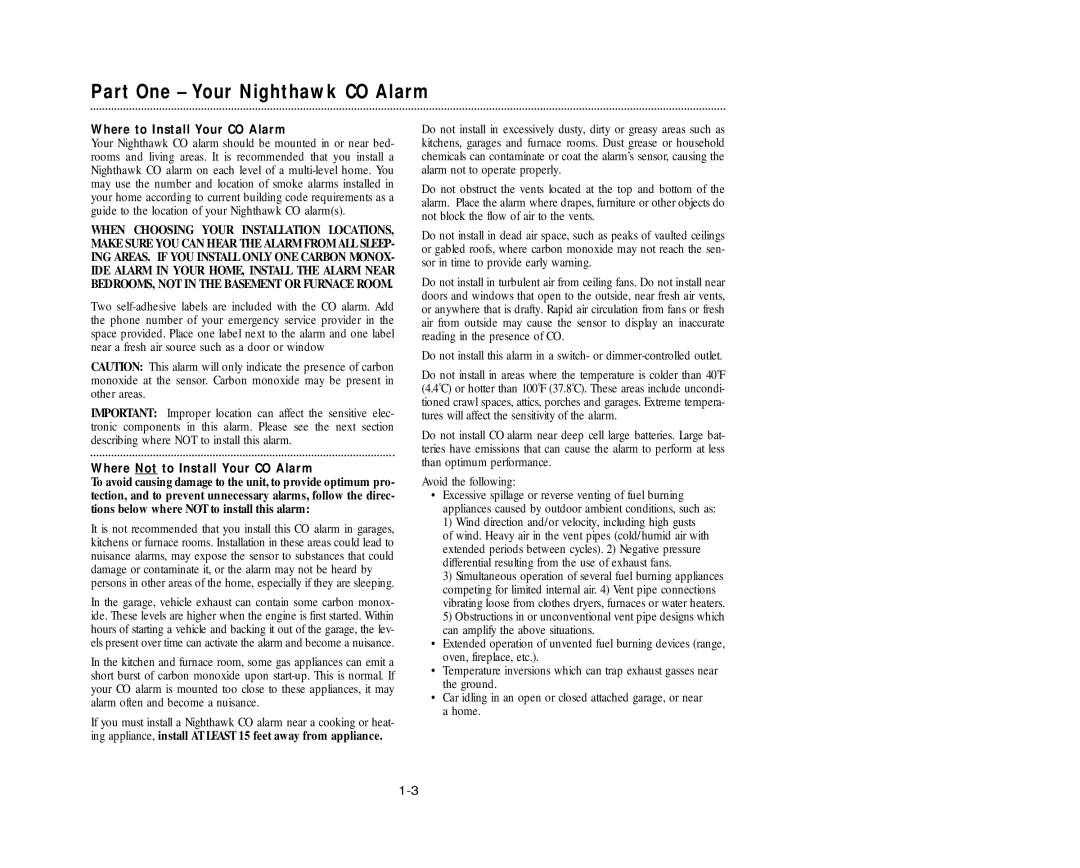
Part One – Your Nighthawk CO Alarm
Where to Install Your CO Alarm
Your Nighthawk CO alarm should be mounted in or near bed- rooms and living areas. It is recommended that you install a Nighthawk CO alarm on each level of a
WHEN CHOOSING YOUR INSTALLATION LOCATIONS, MAKE SURE YOU CAN HEAR THE ALARM FROM ALL SLEEP- ING AREAS. IF YOU INSTALL ONLY ONE CARBON MONOX- IDE ALARM IN YOUR HOME, INSTALL THE ALARM NEAR BEDROOMS, NOT IN THE BASEMENT OR FURNACE ROOM.
Two
CAUTION: This alarm will only indicate the presence of carbon monoxide at the sensor. Carbon monoxide may be present in other areas.
IMPORTANT: Improper location can affect the sensitive elec- tronic components in this alarm. Please see the next section describing where NOT to install this alarm.
Where Not to Install Your CO Alarm
To avoid causing damage to the unit, to provide optimum pro- tection, and to prevent unnecessary alarms, follow the direc- tions below where NOT to install this alarm:
It is not recommended that you install this CO alarm in garages, kitchens or furnace rooms. Installation in these areas could lead to nuisance alarms, may expose the sensor to substances that could damage or contaminate it, or the alarm may not be heard by persons in other areas of the home, especially if they are sleeping.
In the garage, vehicle exhaust can contain some carbon monox- ide. These levels are higher when the engine is first started. Within hours of starting a vehicle and backing it out of the garage, the lev- els present over time can activate the alarm and become a nuisance.
In the kitchen and furnace room, some gas appliances can emit a short burst of carbon monoxide upon
If you must install a Nighthawk CO alarm near a cooking or heat- ing appliance, install AT LEAST 15 feet away from appliance.
Do not install in excessively dusty, dirty or greasy areas such as kitchens, garages and furnace rooms. Dust grease or household chemicals can contaminate or coat the alarm’s sensor, causing the alarm not to operate properly.
Do not obstruct the vents located at the top and bottom of the alarm. Place the alarm where drapes, furniture or other objects do not block the flow of air to the vents.
Do not install in dead air space, such as peaks of vaulted ceilings or gabled roofs, where carbon monoxide may not reach the sen- sor in time to provide early warning.
Do not install in turbulent air from ceiling fans. Do not install near doors and windows that open to the outside, near fresh air vents, or anywhere that is drafty. Rapid air circulation from fans or fresh air from outside may cause the sensor to display an inaccurate reading in the presence of CO.
Do not install this alarm in a switch- or
Do not install in areas where the temperature is colder than 40˚F (4.4˚C) or hotter than 100˚F (37.8˚C). These areas include uncondi- tioned crawl spaces, attics, porches and garages. Extreme tempera- tures will affect the sensitivity of the alarm.
Do not install CO alarm near deep cell large batteries. Large bat- teries have emissions that can cause the alarm to perform at less than optimum performance.
Avoid the following:
•Excessive spillage or reverse venting of fuel burning appliances caused by outdoor ambient conditions, such as: 1) Wind direction and/or velocity, including high gusts
of wind. Heavy air in the vent pipes (cold/humid air with extended periods between cycles). 2) Negative pressure differential resulting from the use of exhaust fans.
3)Simultaneous operation of several fuel burning appliances competing for limited internal air. 4) Vent pipe connections vibrating loose from clothes dryers, furnaces or water heaters.
5)Obstructions in or unconventional vent pipe designs which can amplify the above situations.
•Extended operation of unvented fuel burning devices (range, oven, fireplace, etc.).
•Temperature inversions which can trap exhaust gasses near the ground.
•Car idling in an open or closed attached garage, or near a home.
